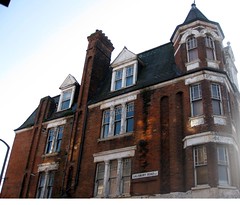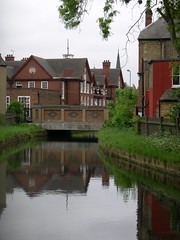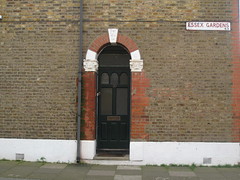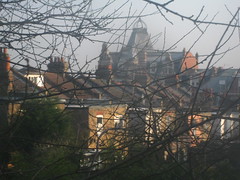English Heritage are currently running a campaign to protect the 9,300 conservation areas in England.
Despite the fact we have our own rich neighbourhood heritage in the form of Grand Parade, the late Victorian and early Edwardian architecture of the Ladder and Gardens and the oldest park in London as well as the traditions surrounding the Harringay Stadium and Arena, inexplicably we are not a conservation area.

However, by the sounds of it, being a conservation area does not necessarily protect an area from neglect, damage and damaging change.
English Heritage revealed the Top 10 threats to our neighbourhood heritage today:
– plastic windows and doors (83% of conservation areas affected)
– poorly maintained roads and pavements (60%)
– street clutter (45%)
– loss of front garden walls, fences and hedges (43%)
– unsightly satellite dishes (38%)
– the effects of traffic calming or traffic management (36%)
– alterations to the fronts, roofs and chimneys of buildings (34%)
– unsympathetic extensions (31%)
– impact of advertisements (23%)
– neglected green spaces (18%).
All but the last one sound horribly familiar, don't they?
What seems depressing to me is that areas where local councils actually have the powers to protect are struggling, so what chances do areas that have not been designated have?
Still, two of the three recommendations seem to make sense for those that are responsible for guiding Harringay's future, namely the Green Lanes Strategy Group and the Neighbourhood management team
Firstly, all departments need to be responsible for conserving a neighbourhood. Some joined up thinking from the council on how Highways, Environmental, Housing, even Health and Education can work together. After all, people's mental and physical health is improved when the area they live in is pleasant, clean and cared for.
Secondly, they believe that local people are the best people to help get the processes going with residents groups helping councils by finding out what local people value, by doing street clutter audits, commenting on planning applications or helping to prepare local lists of historic buildings. Where there is strong community support, projects are much more successful.
The chief executive of EH, Simon Thurley expresses it thus:
Well-cared for [neighbourhoods] ... encourage good neighbourliness, give a boost to the local economy and will continue to be a source of national pride and joy for generations to come.”



Haringey conservation areas 'at risk'
Despite the fact we have our own rich neighbourhood heritage in the form of Grand Parade, the late Victorian and early Edwardian architecture of the Ladder and Gardens and the oldest park in London as well as the traditions surrounding the Harringay Stadium and Arena, inexplicably we are not a conservation area.

However, by the sounds of it, being a conservation area does not necessarily protect an area from neglect, damage and damaging change.
English Heritage revealed the Top 10 threats to our neighbourhood heritage today:
– plastic windows and doors (83% of conservation areas affected)
– poorly maintained roads and pavements (60%)
– street clutter (45%)
– loss of front garden walls, fences and hedges (43%)
– unsightly satellite dishes (38%)
– the effects of traffic calming or traffic management (36%)
– alterations to the fronts, roofs and chimneys of buildings (34%)
– unsympathetic extensions (31%)
– impact of advertisements (23%)
– neglected green spaces (18%).
All but the last one sound horribly familiar, don't they?
What seems depressing to me is that areas where local councils actually have the powers to protect are struggling, so what chances do areas that have not been designated have?
Still, two of the three recommendations seem to make sense for those that are responsible for guiding Harringay's future, namely the Green Lanes Strategy Group and the Neighbourhood management team
Firstly, all departments need to be responsible for conserving a neighbourhood. Some joined up thinking from the council on how Highways, Environmental, Housing, even Health and Education can work together. After all, people's mental and physical health is improved when the area they live in is pleasant, clean and cared for.
Secondly, they believe that local people are the best people to help get the processes going with residents groups helping councils by finding out what local people value, by doing street clutter audits, commenting on planning applications or helping to prepare local lists of historic buildings. Where there is strong community support, projects are much more successful.
The chief executive of EH, Simon Thurley expresses it thus:
Well-cared for [neighbourhoods] ... encourage good neighbourliness, give a boost to the local economy and will continue to be a source of national pride and joy for generations to come.”



Haringey conservation areas 'at risk'
Tags for Forum Posts: heritage, preservation
Replies to This Discussion
-
It may be even be worse. By the end of 2008, only 270 out of 362 local authorities had responded to English Heritage's national census of Conservation Areas at Risk. These were the areas with some 60% of conservation areas. A further 10% of authorities have replied since then. Adding up to coverage of around 70% of all of England’s conservation areas. Now it's possible that some of the most vigilant and effective conservation-conscious councils didn't respond. But I'd suspect the opposite.
As Liz points out, the example of Harringay and Green Lanes shows that the issue isn't only about conservation areas as narrowly drawn.
I've started reading the English Heritage campaign documents. But haven't yet come across a discussion about the fundamental issues - of money and ownership. It may be there.
It is mentioned in passing in the Guardian's report quoting Simon Thurley, English Heritage Chief Executive. "The recession is bittersweet for us. It undoubtedly lifts the presure off some endangered sites, but it has also brought proposed developments that might have saved and found new uses for others to a juddering halt."
One valuable voice in this wider potential debate is that of Michael Edwards, who recently retired as a Professor of Planning at the Bartlett School, UCL. He is especially interesting on how London developers have been able to manipulate the market in land. Thus ensuring their own profits; but at the expense of well-designed affordable housing for millions of Londoners. Here's a link to his blog. It's a bit academicky; though he's also a community campaigner.
-
Alan thanks for the link.
I heard Anna Minton talk on Start the Week on Mon and her book Ground Control about how "untested urban planning has transformed not only our cities, but the very nature of public space, of citizenship and of trust" looks to be interesting reading
-
I heard that too .. the thought that it isn't possible to take photographs of buildings that can be clearly viewed by passers-by is very disturbing..
-
Liz can I please link this to your post about Kings Place Family Weekend.
In some ways, Kings Place is an example of the potentially 'dangerous' hybrid - public space in privately-owned sites and buildings. However, it's an initiative which is making great efforts to get members of the public to use and enjoy it.
Part of that is generating customers and income for its music events, galleries and restaurants. But I have a strong impression that they extend an explicit welcome to the public in general to what is a remarkable building in a very attractive location. (Water on two sides.)
As a tiny example, there's a small Kings Place Flickr group. It's not an official Kings Place site - but Kings Place have joined it and contribute comments. They are obviously aware of the issues raised by Anna Minton and are currently inviting views on the public/private debate.
Photographers are welcome. So if you go, take your camera and add to the Flickr group.
It's close to the London Canal Museum and other places well worth a visit - with or without kids. For instance Camley Street Natural Park; and the British Library. And of course for walks and boat rides on the Regents' Canal. It's not too far to Camden Lock and even Regent's Park.
-
You can see Anna Minton talking about her work in a video from last year (?). She seems to be one of the most interesting, and lively people writing in this field and as a journalist she avoids the dangers of academic ponderousness and government bureaubabble.
Here's the link.
-
This article in the Tottenham Journal highlights the problems faced in Noel Park just up the road. I hate to keep bringing up the East/ West divide in Haringey but one can't help feeling that this level of damaging change would not be tolerated over the train tracks.
Haringey are busy siting enormous new developments in the east but it really should be much higher up their agenda to protect the rich architectural history in this part of the borough much more effectively than they do now. A well-cared for environment has appreciable knock on effects in terms of people's mental and physical health and well-being which surely the east should benefit from as much as the west?
-
There are just as many buildings of historical-value in 'the East' (the area covered by the former Boroughs of Tottenham and Wood Green) as in the west, in fact I would hazard a guess that there are actually more. IMO, the Noel Park Estate should definitely be a conservation area, as well as most of Harringay's Gardens, Ladder and Parade.. Nowt's been done over the last 30 years, so it's going to be an uphill struggle.
Surely the key is to convince the owners/residents of the said areas, that it would be to their 'financial advantage' to own a property there .. and to get them involved, or at least open their eyes to the problem.
-
The Noel Park is indeed a conservation area. Designed by a chap called Roland Plumb, and built by the Artizans labourers and the General Dwellings company.
I am forever advising people to renovate sash cord windows, rather than replacing. It is surprisingly cost effective to have the actual window (slidy up and down bit) made up with a tasteful, yet discreet double glazed unit, this retains the character whilst keeping costs down.
I personally feel it would be a good idea for the council to publicise the fact that the Noel Park is a conservation area, they could target the residents/owners with a booklet that highlights the history, raising awareness and perhaps appreciation. They could use this opportunity to lay down the do's and don'ts when renovating etc. This can always be done in a positive manner, for example how to increase the value of your home/investment.
Being careful not to advertise here... I always mention in the property write up (sales particulars) that the property is situated on the 'Noel Park' conservation area. There are people that take a real pride in their Noel Park properties, but unfortunately, they seem to be in a minority.
-
The Noel Park is indeed a conservation area. Designed by a chap called Roland Plumb, and built by the Artizans labourers and the General Dwellings company.
Thanks for this info Steve. Always found Noel Park fascinating with its variety of design detail.
-
Yes, thanks Steve. Did you see the quote from EH below? They have been enlisting estate agents help to try and get people to see the 'value' to repecting conservation areas.
On Noel Park, if you click through to the Tott Journal article that I linked to, there is a little more on the history and I know that the Big Green Bookshop stocks a book written by a local historian, I think, on the history of Noel Park.
-
I have read that book, I used to be a member of the Hornsey Historical society, I always felt that they did some great work in raising awareness.
I often get Journalists contacting me about the areas we cover. I remember a very positive story from the property journalist Robert Liebman in the Independent.
I was hoping to post a link to his report, but for whatever reason it is not working.
-
Thanks Liz, the Tott Journal article is a good one, as usual I type away without reading the links... Still, thankfully my info is sound!
I really like the fact that the article points people to the new commitee and meetings etc. I will be offering them my full support.
© 2025 Created by Hugh.
Powered by
![]()